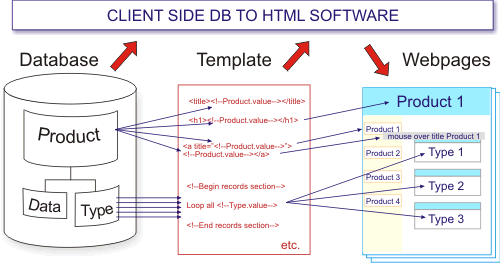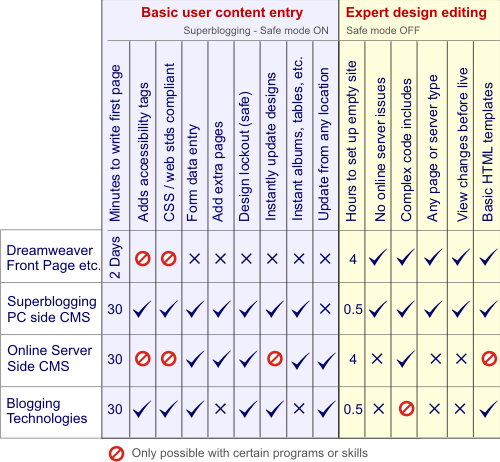DB to HTML will instantly create a content managed website and online shop. No programming is required.
This article will show you how to build a website into which anyone can enter the content then add products from a spreadsheet to make an online shop.
Summary

Client side DB to HTML is seeing a rebirth in popularity. It was common in the early days of the Internet as a simple and reliable way to put large amounts of information online. Users also faired better during the .com crash as their portals cost much less to setup and maintain. These features still apply but today the ease with which new programs build accessible, compliant sites is driving the growth. Aided by the difficulty of building accessible websites in WYSIWYG editors.
DB to HTML techniques are ideally suited to the new web standards producing lightweight, well labelled and SEO friendly code. Content is completely separate from design and some programs allow unskilled users to edit the content, just like an online CMS. Unlike an online database they are simple to set up and can make writing a website as quick and easy than sending a letter.
Comparisons with other software
There are four fundamentally different ways to build a websites. Each format may have variations but generally the advantages and disadvantage for each type are similar.

How Client Side DB to HTML works
Whether you write your own routines or use specialist programs, DB to HTML always works the same way. Take any database and any template or text file. Add special tags in the template and push one button for the software to replace the tags with data from the database:-
1. Individual data - Named tags are replaced with data in the finished page. One named tag can be used in several places, perhaps for the hidden page title and displayed text, a menu name or page link title.
2. Repeated data - Tags are available to start and stop repeated data on each page. To loop rows of text for example. Menu button code is written once then repeated by the software as often as required.
3. Data groups - SQL routines are used to sort what data is included in which group. For example new pages can be started for each entry in a group.
4. Calculated data - Custom tags automatically write page, group or row numbers, counts or toggles etc. Ideal for switching graphics or next-previous links etc.
Learn the tags available with each program and that's all you need to know.
Why use Client Side DB to HTML
- It's very fast. Local software includes more features than browser based apps. Hand code quality is possible, while automated routines save time.
- Reliability and security are better with no servers side to set up. Pages created will run on any server.
- No programming means cost, maintenance and update issues are reduced.
- Content is 100% separate from code.
- Better help tools are possible for unskilled users.
Client side content management
Here we look at Pure SEO CMS, a DB to HTML program designed to create complete websites. The data structure is rigid but has enough options and flexibility for most websites.
For this tutorial we can use Pure SEO CMS's free 5 page website option. Install the program and you'll see a form where you enter the content, just like an online CMS. Anyone should be able to cut and paste text into the form, then press build to create a website. The emphasis is on starting new websites and adding content more quickly than any other way. For now build the site using a standard template. The licensed version has a choice of templates or a CSS Wizard to help create your own
Create PayPal shop buttons from a spreadsheet
Open a PayPal account and create a button for their shopping cart. You will see the price and description in the code so all we have to do is create one of these for every product in our spreadsheet..
Install DB to HTML Express and connect to a spreadsheet of product details. You can include a table as well as the price if you have more information. Run a query to select and organise the data. The program has facilities to create new templates and you will need to set a new page for each category and specify the page names in the layout section. When you build the HTML each product entry will be saved as an individual text file and with just one small table template to write, the whole procedure is very quick.
DB to HTML Express is versatile and will do much more than Pure SEO CMS, but it is therefore more difficult to use and above the ability of most clients. However, in this situation even if the shop's prices change several times a year the client only needs to forward the revised spreadsheet, making the whole procedure easier than hand entry.
Client Side Includes
Online database sites use server side includes to build complete pages from separate pieces of code. Client side programs have similar features but don't need a server. Pure SEO CMS imports text files just like it does a picture. Unskilled users can therefore place the shop button text files wherever they choose. This is much faster than entering each product's details into an online shop by hand.
More possibilities
A shop is an unusual use for DB to HTML software. However, it can save time if there is lots of products information already stored in a database. Other uses may include extracting information from a database when security issues mean the full database cannot be put online. Sometimes dynamic database sites hide information from search engines so having well lots of structured, static pages can increase traffic. Of course, similar solutions may be possible with dynamic sites but DB to HTML is usually faster to design, creates faster displaying pages, is more secure and more reliable. So if you don't need to have an online database it makes sense not to use one. The only negative is hundreds of small static pages in stead of a few larger dynamic ones; but with hosting space so cheap this is rarely a problem.
Comparing performance
Apart from assisting with template design it's clear that the difficulty of WYSIWYG editors to work with the new web standards will continue to reduce their popularity. The future will be content managed sites with non web designers maintaining the text. The options are many, from a simple blogg to a full database driven site.
Having written both client side and sever side websites I don't understand why server side is so dominant. I know that many sites are only possible this way but many others have a real choice. I believe that lack of awareness DB to HTML is the main reason, rather than consideration of the performance. Client side programs have the same SQL commands, are almost instantly set up and are usually easier to design. Sometimes a different website structure may be required but nothing as tricky as running a database online.
DB to HTML site examples
Many successful portals use DB to HTML techniques. www.engineeringtalk.com
An example of what we've discussed is www.thebearingshop.com
Of course, Actinic, one of the most successful ecommerce solutions, also benefits from its own DB to HTML engine.
What is driving the new growth
Modern sites are quicker and easier with DB to HTML software:-
- Accessibility and new web standards compliance are not easy with hand coding or WYSIWYG editors because adding labels to ever link takes too much time. Automated, client side CMS solutions are much quicker.
- Effective websites must be content managed, either to save time or to be used by someone with low IT skills.
- CSS standards encourage content to be separate from design. Make the most of it.
- The speed to create and maintain a site is vital and client side software can be up to 90% quicker.
Other benefits exist but the suitability of client side DB to HTML to work with the new web standards is making the difference.
If you are not using it on at least some of your sites then it's about time you gave it a try.